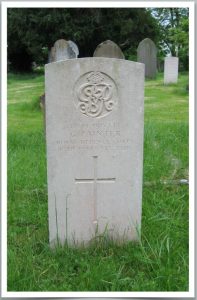Royal Defence Corps

Indications are that George Painter was a former regular soldier, who volunteered his services upon the outbreak of war and served on the home front.
George Painter was born in Fairford in 1866, one of eight children born to George Painter (1838-1918) and his wife Eliza Jane, (née Kimber: 1843-1927).
He spent his early years working on the land with the 1881 Census shows him working as a ploughboy, whilst living in Maisey Hampton.
On 25 December 1899 he married Sarah Ann Brookes at St Peter’s Church in Cheltenham and the town appears to have been his home up to the time of the Great War. However, when the 1901 Census was taken, he was living with his brother Arthur, in Swindon, employed as an engine fitter labourer, whilst his wife lodged with her parents.
The couple had seven children, one appearing to have died in infancy.
By 1911 he was back in Cheltenham working as a labourer for the Borough Council and the family family were recorded as living at 49 Waterloo Street.
Very little documentary evidence has survived relating to George’s military service but there is an Army Pension Record for him which details his apparent re-enlistment in 1915.
He attested for one year’s service in the Territorial Force based in Great Britain on 20 March 1915 at Cheltenham. He stated his age to be 48, his address as 49 Waterloo Street, Cheltenham and his occupation as a labourer.
His attestation papers also note previous service with the Gloucestershire Regiment and the National Reserve. He was posted to the Gloucestershire Regiment and assigned his former number, 3977. This number was originally allocated in mid 1893 and George probably served an initial six years ‘with the Colours’ and a further four in the Reserve.
Having volunteered his services, George was assigned to No 3 Railway Company of the 5th Battalion of the Gloucestershire Regiment.
On 7 April 1915 he was assigned to ‘Super Company No 1 ’ (which was probably one of the Super-numerary Territorial Force (TF) Companies) and later to 82nd Provisional Company and this eventually became the 17th Battalion of the Glosters.
He was to serve for one year and 26 days before being discharged at Kirby-le-Soken, Essex, on 14 April 1916, as no longer physically fit for military service.
A medical examination undertaken upon attestation declared that he was free of organic disease and fit for duty at home which did not entail prolonged exertion or marching more than ten miles.
Prior to discharge he underwent a medical examination at Clacton on 8 March 1916, where, it was noted, that he had been suffering from rheumatic fever and aching in the shoulder and arms, whilst working on the railway.
He was diagnosed as suffering from vascular disease of the heart and rheumatism.
He does not appear to have been issued with a Silver War Badge to denote previous military service, so possibly he was re-engaged at short notice, in a less strenuous home service role? In the absence of any service papers, we just don’t know.
The Supernumerary TF Companies were absorbed into the Royal Defence Corps (RDC), when it was formed in March 1916. It is believed that the personnel of these companies were transferred from the TF and as their conditions of service were changed were given new five digit numbers. This could have been the case with George Painter who was given the number 29501.
The RDC undertook a variety of duties, suitable for veterans, older age men or those who had suffered wounds and were no longer fit for front line service; guarding prisoners of war was a prime function.
At some point he was posted to the Labour Corps (with the number 696299) and as with the RDC, the Labour Corps undertook a wide range of roles, suitable for men unfit to serve in front line duty.
He appears to have still been serving on 19 February 1920, as the Register of Soldiers’ Effects (RSE), held at the National Army Museum, states that he died at Connaught Hospital in Aldershot which was a military establishment and again he does not appear to have been in receipt of a Silver War Badge.
According to a recently released Pension Record Card (PRC) the cause of death was ‘paraplegia ’ but it is not known if this was as result of an accident, whilst serving?
George Painter was aged 54 when he died and was buried in the churchyard of St Mary’s, Fairford, his birth town where a standard CWGC headstone marks his grave and this bears the badge of the RDC.
There is a sad twist to this story because George’s wife, Sarah Ann had died in 1918 meaning that when George died two years’ later, their six surviving children had become orphans. The PRC details that all, with the exception of the eldest, George James (born in 1901) went into guardianship.
Sarah Ann’s mother, Mrs Brookes, who lived in Cheltenham, took in William Henry (born 1904), Rosina May (1908) and Alfred Maisey (1914). An aunt, Ellen Reynolds of Plumstead Green, Norfolk, took in Edward George (1910) and a great aunt, Mary Little, who lived in Birmingham, had Elsie Gladys (1912).
So the Painter family children were split up and it is not known if they were ever re-united.
Research by Graham Adams 17 February 2021
